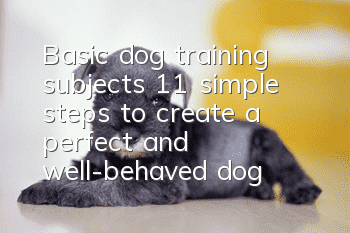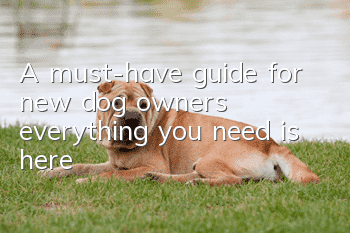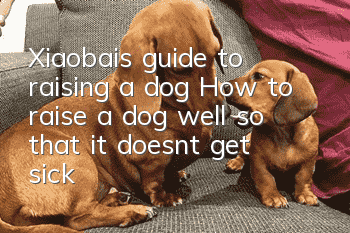Basic dog training subjects: 11 simple steps to create a perfect and well-behaved dog

Dog recall training
The purpose of this training is to enable the dog to smoothly come to the owner's left side and sit down according to the owner's gestures and commands under any circumstances. When training, first call the dog's name to attract the dog's attention, and then issue the command "come" and make the come gesture with your right hand (stretch your right hand forward and then put it down naturally). At the same time, pull the training rope with your left hand and step back to make the dog move forward. Come, when the dog comes to the owner, it should be rewarded in time, so that after many times of training, the dog can come according to the command.
However, it should be noted that some dogs often fail to come after hearing the command or seeing the gesture. At this time, the owner must be patient and try to take any action that is enough to excite the dog, such as backing up, clapping and squatting, and moving in the opposite direction. Rushing, etc. will prompt the dog to come forward. Do not use sudden movements to catch or chase the dog, otherwise the dog will be affected. After some dogs are stimulated by new things, not only do they not come, but they run around. At this time, you should grab the training rope, use a threatening command, and make a come gesture with your right hand to make the dog come. When the dog comes to your side, reward it in time.
Dog accompanying training
When training, first clean the flat ground, hold the leash with your hand, call the dog's name to attract the dog's attention, and issue the command "reliable" while using your left hand to pull the leash Pull the belt forward and move forward at a faster pace, walking no less than 100 meters each time. When the dog appears to be ahead or behind, immediately issue the "reliance" command to correct it, and pull the leash once to stimulate the dog. In order to form the conditioned reflex of the gesture, you can use your right hand to pull the leash and keep it longer. When the dog once leaves the correct position, while giving the "reliance" command, pat your left thigh with your left hand, repeat this many times. Training can form a conditioned reflex. When the dog can follow the command correctly without a leash, it can be trained to change speed, direction and in more complex environments. When the dog is stimulated by novel stimuli and does not execute the command, it can issue commands with threatening tones and cooperate with them. Correct with stimulation from the leash.
Dog holding training
Handling is the basis for training in various subjects. It is also an action often trained by toy dogs. Its purpose is to train the dog to hold objects to its owner. Latching training is a relatively complex movement, including "biting", "spitting", "coming", "identifying", etc. Therefore, the training must be carried out step by step and gradually formed, and cannot be done too hastily.
First of all, it should be trained to develop the conditioned reflex of "title" and "spit" commands. Training methods should be treated separately according to the dog's neurological type and special circumstances. Generally, induction and forced methods are used.
When training with the induction method, you should choose a quiet environment and items that can easily arouse the dog's excitement. Hold the object in your right hand and shake it quickly in front of the dog to arouse the dog's excitement. Then throw it 1 to 2 meters away and immediately give the "hold" command. When the dog reaches the object and wants to pick it up, repeat it.Give the "hold" command. If the dog holds the object, give the "good" command and a petting reward. Let the dog hold the object in its mouth for a moment (about 30 seconds), and then issue the "spit" command. After the owner takes the object, Food rewards should be given. After repeated many times, conditioned reflex can be formed.
Some dogs must be trained using forced methods. At this time, make the dog sit on the left side of the owner, give the "hold" command, hold the object in the right hand, open the dog's mouth with the left hand, put the object into the dog's mouth, and then support the dog's lower jaw with the right hand. In the early stage of training, after the dog holds it for a few seconds, the "spit" command can be issued, the object will be taken out, and a reward will be given. After repeated training for many times, you can perform "title" and "spit" training according to the command. On this basis, the ability to pick up thrown objects and deliver items is further developed, so that the dog can be trained to have the ability to identify and covert pick ups. When training to pick up thrown objects, it should be done in combination with hand gestures (the right hand points to the object to be picked up). When the dog holds the object, it can give the "come" command, and reward it after spitting out the object. If the dog does not come with the title, you should use the training rope to control it and make the dog come.
Dog Barking Training
The Shilling dog sits down, tie one end of the leash to a solid object, and give the "bark" command and gesture (right hand half extended, palm down, Do grabbing movements toward the dog 3 to 4 times), and at the same time use food to lure the dog in front of it. Because the stimulation of the food causes the dog to be excited, but the dog cannot eat the food, the dog will bark. In the early stage, food rewards should be given after barking, and then the rewards should be gradually reduced until the rewards are completely eliminated, so as to develop the requirement to bark only by listening to commands and looking at gestures.
In addition, the dog's ability to bark at objects that cannot or cannot be held should also be cultivated. To this end, you can use the most exciting items for the dog, place them out of the dog's reach, ask the dog to pick them up, and give the "bark" command. If you can bark, reward them immediately, and take out the items for the dog to pick up. Take the title. By repeating this for many times, the dog can develop the ability to bark for items that cannot be held or cannot be held.
Quiet dog training
When training this action, another person first approaches the dog with a sneaky movement. When the dog wants to bark, the owner should give the "quiet" command and make gestures at the same time (putting Place your right hand in front of your mouth, extend your index finger (in line with the nose), and tap the dog's mouth to prevent the dog from barking to keep it quiet.
- Why do dogs get kidney stones? What are the symptoms of kidney stones in dogs?
- Which foods are dangerous for dogs to eat? They can cause illness or death in severe cases.
- What should dogs eat when they are sick? Dietary recommendations for dogs when they are sick
- Why do dogs like to hide food? Do you need to correct it?
- What does whole dog food mean? Can puppies eat whole dog food?
- List of things dogs cannot eat. You must have fed these things before
- How to feed golden retrievers to grow fast. Don’t think that growing fast is good.
- What to do if Bichon Frize has diarrhea? Is it dog plague?
- What to do if a puppy has diarrhea? What causes diarrhea in a puppy?
- What will happen if dogs eat human food? Why can’t they eat human food?



